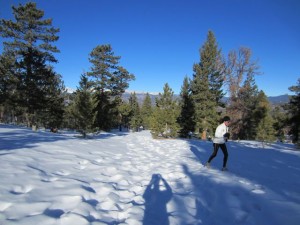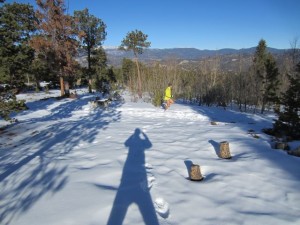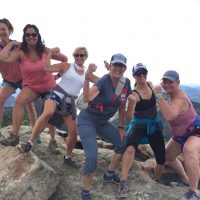 Winter can be a challenging time for runners. Depending on where you are in the country, you could be facing arctic temperatures, freezing windchill, ice, rain, snow, and anything else that Mother Nature can craft to send our way! As I write this in Estes Park, Colorado, we are at 15F – last night the low was around -15F, and at my usual run time this morning it was around -10F! That coupled with 6 or 7 inches that fell over the last couple of days, means that conditions underfoot are pretty slick. My ordinary trail shoes are great in soft snow; however once the snow gets packed down and ice settles in, you really some form of traction to help your stability and footing – this post is all about my experience over the Winters here in Colorado, and what I have used to help me keep my footing in tricky conditions in the Rocky Mountains.
Winter can be a challenging time for runners. Depending on where you are in the country, you could be facing arctic temperatures, freezing windchill, ice, rain, snow, and anything else that Mother Nature can craft to send our way! As I write this in Estes Park, Colorado, we are at 15F – last night the low was around -15F, and at my usual run time this morning it was around -10F! That coupled with 6 or 7 inches that fell over the last couple of days, means that conditions underfoot are pretty slick. My ordinary trail shoes are great in soft snow; however once the snow gets packed down and ice settles in, you really some form of traction to help your stability and footing – this post is all about my experience over the Winters here in Colorado, and what I have used to help me keep my footing in tricky conditions in the Rocky Mountains.
My first foray into traction devices led me to try YakTrax and Stabilicers. They had both come recommended from different folks, so I thought I would give them a try. Both devices rely on the same idea, that you stretch a rubber or elastic “cage” over the bottom of your shoes. The cage then has wire coils wrapped around that give traction in the case of YakTrax, or cleats screwed into the base with Stabilicers. I was pretty excited on the first runs using one of these devices. Both gave reasonable traction in a combination of ice and packed snow – my favorite at that time were the YakTrax, just because they allowed more freedom of movement for me; the Stabilicers were a little rigid to really suit my freeflowing running. Just a personal thing…
So I continued to use the YakTrax, and then hit a couple of snags. The first was that the straps keeping the YakTrax on my shoes would need re-adjustment  during a run. Running as I do mostly on trails, I’m not sure if this was due to the terrain or not – one thing for sure, it got pretty frustrating for me. I just got to a place where I was in flow, and then realized that the YakTrax had moved, so I wasn’t getting the same traction still. This seemed to happen to only one foot at one time…go figure…
during a run. Running as I do mostly on trails, I’m not sure if this was due to the terrain or not – one thing for sure, it got pretty frustrating for me. I just got to a place where I was in flow, and then realized that the YakTrax had moved, so I wasn’t getting the same traction still. This seemed to happen to only one foot at one time…go figure…
Of course I’m running in cold temps, windy, and the last thing I want to do is an unplanned stop to take gloves off and refix a YakTrax! Then the biggie happened – the rubber “cage” snapped underfoot! This meant that the structure collapsed, and I was left with one Yaktrax on, and one in my hand! One footed traction didn’t sit well with me – of course it always happens when you are a ways from the trail head, rather than just as you are climbing into your car! Taking them back to the supplier, I was told that they were outside the warranty period, so I had to invest in another set! Ugh….I think I went through three sets of YakTrax like this. I was just beginning to think that winter running was always going to be trixy, and then something new landed with me!
 A good friend, and someone whose opinion I trust and has a huge experience of running, especially on trails, recommended a product called Icespike to me. The concept has been around for a while, screws that you literally screw into the sole of your shoes. The beauty of these babies is that the screws are 10 times more durable than standard screws…like their advertsing says, Icespikes are “like sheet metal screws on steroids!”
A good friend, and someone whose opinion I trust and has a huge experience of running, especially on trails, recommended a product called Icespike to me. The concept has been around for a while, screws that you literally screw into the sole of your shoes. The beauty of these babies is that the screws are 10 times more durable than standard screws…like their advertsing says, Icespikes are “like sheet metal screws on steroids!”
The first thoughts I had before I tried running in them the first time was how would this effect my form, would I feel the screws, and what difference would it make to traction for me? Well, these questions were soon answered. On the first run out with Icepsikes on a pair of Mizuno Wave Ascends (pic left) my form felt entirely just as it did without the traction device. I didn’t feel the screws either – the only thing that was different was the “crunch’ sound with every footstrike. And traction – felt fantastic! Occasionally on really slick surfaces I would get some initial slip, and then the screws bit home, and drive restored. Even changing surfaces from trail to tarmac didn’t phase the Icespikes – the sound underfoot changes, and that’s it. Of course running on road on concrete will wear the heads of the screws down more quickly – still way better than stopping and taking off another device! The only thing I need to do is to keep a check on wear rate on the screw heads. When they are worn, I simply unscrew the old, and replace. The pack comes with 30 screws, which is usually enough to last me through a whole Winter. I use 10 on each shoe, with 6 on the forefoot, and 4 on the heel – I am a forefoot striker. You can buy another pack of screws when you run out as well. A number of trail and ultra runners are now using them, including multiple US trail running champion Michele Yates! Good recommendations…
 One of the things that I appreciated best about this product is that you don’t have any restrictive or bulky attachments. You don’t have a cage that you have to strap around your shoe that restricts movement. Pretty much I run just like I do the rest of the year, certainly at a reduced pace, while definitely feeling relaxed and able to enjoy those beautiful Winter runs! My process now is that I have one pair of shoes all Winter long that have Icespikes permanently inserted. I take them along on every run and use them whenever conditions dictate. Icespikes have made a huge difference to my Winter training – give them a try, and tell them I sent you their way!
One of the things that I appreciated best about this product is that you don’t have any restrictive or bulky attachments. You don’t have a cage that you have to strap around your shoe that restricts movement. Pretty much I run just like I do the rest of the year, certainly at a reduced pace, while definitely feeling relaxed and able to enjoy those beautiful Winter runs! My process now is that I have one pair of shoes all Winter long that have Icespikes permanently inserted. I take them along on every run and use them whenever conditions dictate. Icespikes have made a huge difference to my Winter training – give them a try, and tell them I sent you their way!



More tips on running on ice, including how it can make you a better runner.
http://www.runuphillracing.com/write/RunningonIce.html